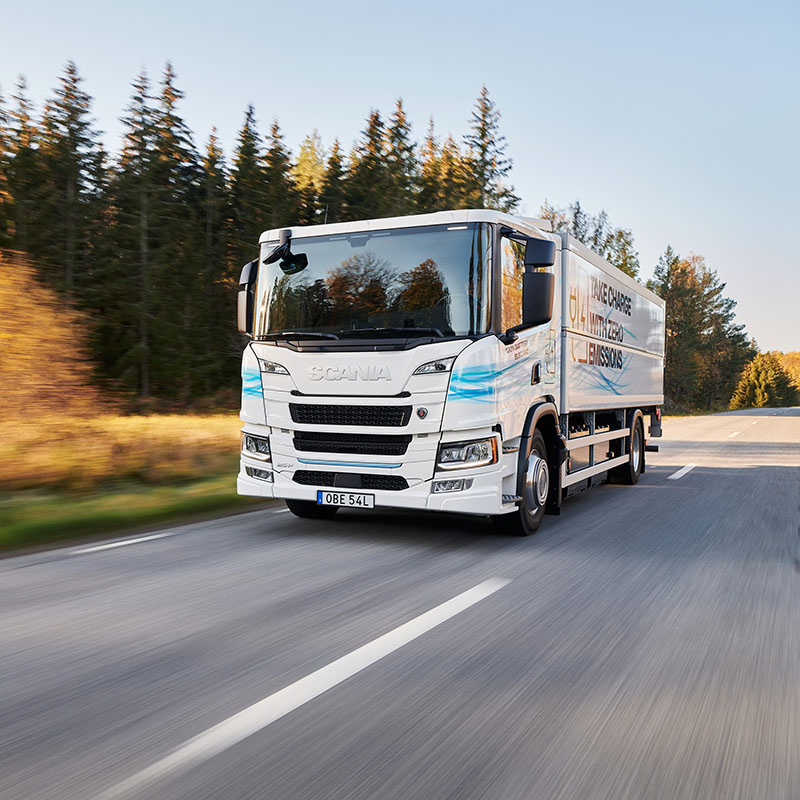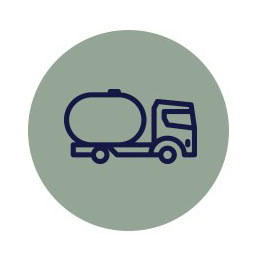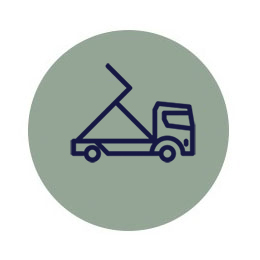
Consultative Sales Process
Want to be contacted for a personal meeting or call with an electrification expert?
Never before has the future of road transport been this complex. But at the same time, there has never been such a strong commitment to turning the vision of a sustainable transport future into a reality. The promise from us at Scania also goes far beyond making and supplying great sustainable electric vehicles. We intend to make sure you can approach electrification and implement it in a manner and pace that suits your business and operation.
THE PATH TO ELECTRIFYING YOUR OPERATION
As soon as you are considering your first steps towards electrification, we can help – because every worthwhile journey needs to start with a conversation about where we want to go and what we want to achieve. The process from there-on is all based around your needs, your wishes and your prerequisites.

Your sustainability targets
If you have an ambition to electrify, we’ll find a way to achieve it in a way that suits your business. And this is equally true no matter if you want to be at the forefront of the transition, or follow more cautiously behind. Either way, the time to start planning is now – so that you can stay in control of the timeline.

Your operation
Nothing shows a clearer picture of your operation than real data from your own vehicles. We’ve developed in-house analysis tools that accurately project your electric range per transport type, optimal charging locations, as well as which routes to electrify in which order – depending on the releases ahead in our future vehicle roadmap. All taking driver behaviour, payload, climate, elevation and other factors into account.

Your prerequisites
With electrification in general, and charging specifically, the prerequisites matter a lot. Do you have one or multiple depots? Fixed transport routes? Are just-in-time deliveries prioritised higher than energy cost? What is your grid capacity and upgradability at your depots, loading or unloading locations? Consider us your general contractor – with thorough on-site visits to facilitate both the planning and installation of your charging solution.

Your solution
The goal in the end is to provide you with a solution that works from day one – but at the same time scales well for your future business. The consultative sales process will result in a turn-key solution where Scania takes holistic responsibility, and covers:
- The right vehicle specifications and bodyworks integrations, with appropriate Repair & Maintenance contracts
- Charging hardware and software, including physical installation and infrastructure implementations
- Financing and insurance for both vehicles and charging hardware
- A tailored package of services, aimed at maximising energy efficiency, uptime & productivity, administrative support and ensuring the best possible total operating economy – all according to your specific priorities.
EXAMPLE SOLUTIONS
With solutions built around brand new and sometimes even future technology, we are unable to compile reference customer cases of full solutions actually in use. At the same time we want to show you examples of the full scope of an electric solution – down to the details. As such, we have created what we call customer archetypes built around real-world business scenarios, defined and developed using our consultative sales process. Two examples of these cases are described below at a very high level – but in our future conversations you can expect to be able to review them in quite a detailed fashion.
Archetype customer

This company has a long-term contract to transport sand from a second party owned sand pit to their customers – usually to be used in manufacturing processes. The operation owns and operates a 15-truck fleet of 6x2 rigid trucks with 5-axle trailers with 64t GTW, and 4x2 tractors with 3-axle semitrailers with 40t GTW – from multiple manufacturers, and all with bulk tanks. The company depot is located at the sand pit, where the trucks are loaded each morning before their 300 km route to their destinations. At the destination the unloading process provides the perfect opportunity for the drivers to take their lunch break before their 300 km return trip. The transports are not sensitive in terms of just-in-time delivery, but ideally the roundtrip should be covered in one day.
Electrification plans: Replace three vehicles yearly, until all 15 are replaced. All from Scania.
Priorities: Payload first, energy efficiency second
SOLUTION
Vehicles
- Three Scania 4x2 trucks with R-cab and 350 kW CCS charging – with three new added per year until all 15 trucks of the fleet have been replaced
- Three-axle dry bulk trailers. 40t GTW
Charging
- Scalable charger and management system that will enable depot charging.
- 600 kW power unit and three 20-300 kW satellite chargers for depot overnight charging – adding further power unit upgrades and additional satellite chargers yearly
- 2 x 350 kW all-in-one chargers and 1 x 150 kW Battery integrated Charger for destination top-up charging during unload & driver lunch break, which in 35 minutes charges enough for the empty load return trip.
- The Battery Integrated Charger is supplied on a lease during the 12-month upgrade process of the grid capacity to support a third permanent 350 kW all-in-one charger at the last destination.
- Charging Management System (CMS) that covers both the depot charging, and the destination chargers with charge scheduling, power optimisation as well as notifications – with a payment solution added that allow spare capacity at the destination chargers to be sold to third parties for charging their vehicles.
- Full Scania responsibility for installation of hardware, on-site training of staff, and solution maintenance.
Services
- With payload as the top priority, the services recommendation is primarily based around Core Services, facilitating smooth day-to-day operation, ensuring that vehicle administration or needs never get in the way of the transport operation, and providing peace of mind related to entering new technology.

This company runs a fleet of 10 trucks, and transport dairy products from factories to central warehouses and large retailers. Starting each morning at their depot, their average daily transport distance is about 330 km, going between urban areas on mostly flat roads – with an overall average speed of 60km/h. Each trip starts fully loaded, and the return trips at the end of each day are done completely empty. This increases the possible range – and makes overnight depot charging a quick and easy implementation that is fully capable for their transports needs. The company is being paid per cubic metre per kilometre, with perishable goods and penalties for late deliveries.
Electrification plans: Start with three vehicles, as a pilot to evaluate further electrification at a later time.
Priorities: Uptime is the top priority, and energy efficiency second.
SOLUTION
Vehicles
- Three Scania 4x2 trucks with R-cab and 350 kW CCS charging
- Three-axle box trailer with refrigeration. 40t GTW
Charging
- Charging solution based around overnight depot charging without quick-charging needs.
- Three standard 50 kW wall boxes
- Connected to existing grid capacity with no immediate need for upgrade
- Basic Charging Management System (CMS)
- Installation by third party with Scania oversight
- The site is prepared for further in-ground cabling to support future wall boxes.
- Scalability for the future through upgrading the charging management system to a more advanced version with load balancing and charge scheduling – utilising existing capacity to the maximum.
Services
- With uptime as the top priority, the services recommendation is primarily based around Uptime Services as an addition to Core Services. This allows the customer to stay ahead of issues, preventing them from impacting their transports, but also providing deep insights into vehicle status and maintenance needs, proactively solving potential problems and ensuring maximum uptime and productivity.

This company operates a majority Scania mixed fleet of 20 vehicles, of which 10 are hooklifts with trailer. They transport their own containers which they set up at building sites to collect waste, then transports further to waste sorting facilities and on to recycling plants. At night, the trucks are parked at the depot, which has enough available electrical power to electrify a few of their trucks – but more power can be achieved with some construction work. The fleet operates three days per week in urban contexts without trailers, a total weight of between 15 and 27 tonnes for their ten 25 km round-trips at 40 km/h average speed with 5 minutes of hook lift usage. Two days per week they perform regional transports at a total weight of between 20 and 44 tonnes, for two daily 220 km round-trips on mostly flat roads with average total speed of 60 km/h and 5 minutes of hook lift usage per trip. The company is paid per tonne per km, and since waste handling is a business with a high sustainability focus, there’s high pressure to have and implement sustainability plans.
Electrification plans: Start with three vehicles, scaling up to 10 vehicles within five years.
Priorities: Payload is the top priority, and energy efficiency second
SOLUTION
Vehicles
- Ten Scania 6x2*4 trucks with R cab, 375 kW CCS charging and hooklift.
- Two-axle glider trailer. 40 t GTW.
- Three delivered for the first year, all ten delivered within five years.
Charging
- To allow the customer to start electrifying immediately, despite lacking sufficient power grid infrastructure, the implementation is done in two stages.
- Stage 1 – Year 1: Three trucks in urban operation with temporary overnight depot charging solution.
- 3 x 40 kW portable chargers, rented to the customer
- Basic Charging Management System (CMS). It’s simple, plug-and-play and requires no training – but provides follow-up power consumption reports and some other basic functionalities at low cost
- Grid capacity upgrade planned and implemented during year one
- Stage 2 – Year 2+: Adding three trucks for regional operation, with top-up charging at depot – and implementing long-term charging solution.
- 300 kW triple power unit, with 300 kW capacity and six 20 kW – 300 kW charging satellites
- 300 kw of additional power units are installed as the fleet grows, allowing capacity for both top-up charging and overnight charging of BEVs
- The site is prepared for further in-ground cabling to support future charging satellites
- Advanced CMS is installed which features functionality for scheduling, power optimisation and notifications – as well as dynamic power routing between satellites to enable high power top-up charging. The customer staff is trained on-site by Scania
- All installations done by Scania in cooperation with certified suppliers.
Services
- With payload as the top priority, the services recommendation is primarily based around Core Services, facilitating smooth day-to-day operation, ensuring that vehicle administration or needs never get in the way of the transport operation, and providing peace of mind related to entering new technology. The solution is also complemented with a few of the Energy efficiency services, and Uptime services.
OUR PROMISE
Electrification changes everything. Everything but our promise to be there for you, guiding you through the transition, and ensuring that you’ll get a high-quality solution that truly works for you, your operation and your business. Both short and long-term.
MORE PARTS OF OUR SOLUTIONS
WANT TO FIND OUT MORE ABOUT OUR CONSULTATIVE SALES PROCESS?
Just reach out to your local Scania representative and we’ll get the conversation started.